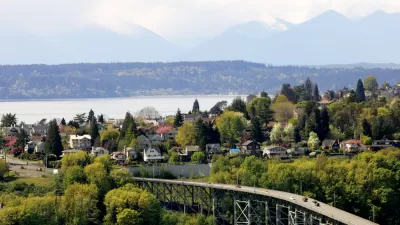It's going to take "radical policies" and "political courage" to overcome the housing shortage in California, according to a recent working paper, but they will be necessary to overcome the negative consequences of the planning and zoning status quo.

A new working paper [pdf] byJenny Schuetz, from the Brookings Institution, Metropolitan Policy Program, and Cecile Murray, from the University of Chicago, recommends building more housing as a solution to the housing affordability crisis in California.
The report, written for a working paper series from the Terner Center for Housing Innovation at the University of California at Berkeley, uses new data from the Terner Center California Residential Land Use Survey to examine how zoning deters the development of new multi-family buildings.
"Too many of California’s high-rent cities have built too few apartments, contributing to the current shortage," concludes the article that promotes the new working paper.
One challenge facing zoning reforms intended to encourage new supply of multi-family residential explored by the working paper is the multitude of tools local governments have to obstruct the construction of such residential buildings.
"Many communities simply ban multifamily buildings outright on most of their land," according to the post. "Whereas the median California city allows single-family homes on at least 50 percent of land, the typical city allows apartment buildings on less than 25 percent of land (Figure 2). Even where apartments are allowed, local governments often restrict building heights or apartment densities to a degree that makes development financially infeasible."
The article also lists ad hoc discretionary approval processes to add risk to the development process and deter many developments.
FULL STORY: CALIFORNIA NEEDS TO BUILD MORE APARTMENTS

Planetizen Federal Action Tracker
A weekly monitor of how Trump’s orders and actions are impacting planners and planning in America.

Restaurant Patios Were a Pandemic Win — Why Were They so Hard to Keep?
Social distancing requirements and changes in travel patterns prompted cities to pilot new uses for street and sidewalk space. Then it got complicated.

Map: Where Senate Republicans Want to Sell Your Public Lands
For public land advocates, the Senate Republicans’ proposal to sell millions of acres of public land in the West is “the biggest fight of their careers.”

Maui's Vacation Rental Debate Turns Ugly
Verbal attacks, misinformation campaigns and fistfights plague a high-stakes debate to convert thousands of vacation rentals into long-term housing.

San Francisco Suspends Traffic Calming Amidst Record Deaths
Citing “a challenging fiscal landscape,” the city will cease the program on the heels of 42 traffic deaths, including 24 pedestrians.

California Homeless Arrests, Citations Spike After Ruling
An investigation reveals that anti-homeless actions increased up to 500% after Grants Pass v. Johnson — even in cities claiming no policy change.
Urban Design for Planners 1: Software Tools
This six-course series explores essential urban design concepts using open source software and equips planners with the tools they need to participate fully in the urban design process.
Planning for Universal Design
Learn the tools for implementing Universal Design in planning regulations.
Heyer Gruel & Associates PA
JM Goldson LLC
Custer County Colorado
City of Camden Redevelopment Agency
City of Astoria
Transportation Research & Education Center (TREC) at Portland State University
Camden Redevelopment Agency
City of Claremont
Municipality of Princeton (NJ)





























